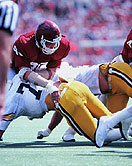- Skip Storing This Everyday Product in the Fridge Door
- Green Tea + B3 Pairing May Boost Brain Health
- Navigating Your Midlife Crisis: Embracing New Possibilities
- City Raccoons Showing Signs of Domestication
- Mapping the Exposome: Science Broadens Focus to Environmental Disease Triggers
- One Week Less on Social Media Linked to Better Mental Health
- Your Brain Changes in Stages as You Age, Study Finds
- Some Suicide Victims Show No Typical Warning Signs, Study Finds
- ByHeart Formula Faces Lawsuits After Babies Sickened With Botulism
- Switch to Vegan Diet Could Cut Your Greenhouse Gas Emissions in Half
Former NFL Players May Be Plagued With Chronic Headaches


Some retired NFL players live with nearly constant headaches, and their misery is frequently punctuated with skull-splitting migraines, a new study reports.
An evaluation of eight retired football pros found that the former players averaged more than 19 headache days per month. Twelve of those 19 days involved migraines, said study author Dr. Frank Conidi, director of the Florida Center for Headache & Sports Neurology in Port St. Lucie, Fla.
“Almost every other day these players are having migraines, and some were actually having them every day,” said Conidi, who is scheduled to present his findings Wednesday at the annual meeting of the American Headache Society in Los Angeles. Findings presented at meetings are generally considered preliminary until they’ve been published in a peer-reviewed journal.
By comparison, the average incidence of headache for all men is three to four a month, he said.
Only 3 percent of the general population suffers from chronic headache, or 15 or more headache days per month, according to the International Association for the Study of Pain.
Worse, nearly all the players told Conidi that they were not receiving any treatment for their headaches.
“Only one of the eight had insurance, and that was the only one being treated appropriately for his migraine headaches,” Conidi said. “These are retired professional athletes without access to health care. That is shocking.”
The headaches most likely are caused by concussions that the players experienced on the field. The retirees told Conidi that they had experienced more than seven concussions on average during their years of play.
The average age of the eight players is 37, and they played an average 4.6 years in the NFL.
“I’m not surprised by these findings,” said Dr. David Dodick, director of the Sport Neurology and Concussion Program at Mayo Clinic in Scottsdale, Ariz. “Headache is the most common symptom of concussion, and persistent headache is one of the most common symptoms of repeated concussions.”
Dodick said he also isn’t surprised that the players were not receiving specialized care for their headaches, given that there are only about 400 board-certified headache specialists in the United States.
“Only 4.5 percent of Americans have access to specialty care, get a diagnosis and actually get specialty care for headache or migraine,” Dodick said.
Testing revealed that seven of the eight players suffered from depression and anxiety. Two-thirds have problems concentrating or paying attention, and half have trouble with their memory or with executive function skills like planning or organizing.
MRIs found actual evidence of brain injury in three of the eight players, Conidi reported.
These mental problems may be part of the reason why they aren’t getting appropriate care, Conidi said.
“I asked them, ‘Why didn’t you get Obamacare?'” he said. “They said they didn’t know about it. They didn’t know they were eligible.”
The NFL needs to do a better job making sure that retired players get the medical care they need, Conidi said.
“I think these people would have much fewer headaches if they had access to proper care,” he said.
Concussion-related headaches can affect football players at any age or level of play, Dodick said.
“I see kids 12 years old, 13 years old, who have suffered repeat concussions and are disabled with headache,” he said. “This is not confined to professional athletes.”
That said, players in the NFL appear particularly susceptible to concussion and the headaches that result.
“The players are bigger, stronger, faster,” Conidi said. “You’re looking at much harder collision, which would put them at high risk for concussion.”
Dodick said the game could be made safer, with stricter penalties for helmet-to-helmet contact, better detection of concussions during games, and the cultivation of mutual respect between players so they don’t target each other for harm.
He believes that these findings actually downplay the violence on the field and its aftereffects.
“We’re kidding ourselves if we think these players only had seven concussions. That may be the number of diagnosed concussions, but they’ve clearly suffered concussion more often than that,” Dodick said. “This is a wake-up call, in so far as a substantial number of these young retired NFL players are suffering from cognitive impairment and disabling pain.
More information
Learn more about headaches from the National Headache Foundation.
Source: HealthDay
Copyright © 2025 HealthDay. All rights reserved.










